-1.png?width=411&height=230&name=2021-08-Newsletter-Images%20(2)-1.png) In early March, the team at Encentiv Energy hosted our annual Utility Rebates: What’s New in 2023 webinar, where we reviewed information about 2023 utility rebate trends including LED rebate program changes by state, product category, and program for both downstream and midstream. View the webinar →
In early March, the team at Encentiv Energy hosted our annual Utility Rebates: What’s New in 2023 webinar, where we reviewed information about 2023 utility rebate trends including LED rebate program changes by state, product category, and program for both downstream and midstream. View the webinar →
The presentation also included information about various other technologies, such as networked lighting controls, horticultural lighting, HVAC, Ultraviolet Germicidal Irradiation, and Electric Vehicles, and the chargers powering them.
Information for the webinar was gathered utilizing our Encentivizer tools and our UtilityGenius platform, a free public platform hosting business, commercial, and industrial utility rebate program information. These tools are powered by our proprietary database which consists of thousands of utilities in the US and Canada that are analyzed and updated daily by our team of rebate experts, with tens of thousands of unique incentive calculations, as well as every detail you need to know on hundreds of thousands of qualified products.
The information presented was collected between Mid-February 2022 - End-February 2023 when most calendar year programs have completed their changes. Program changes were also filtered for the highest rebate value changes for each utility program product category over that period. Aggregate values are computed as a percentage change, averaged across each aggregation type, excluding programs that don’t offer commercial and industrial incentive programs.
LED Rebate Program Changes by State: Downstream
Downstream incentives, sometimes referred to as prescriptive, are rebates applied for and received by the end customer after the purchase of equipment. The application process can sometimes be paperwork intensive but are a mainstay in LED rebate program offerings, with almost all programs that offer energy efficiency incentives providing a downstream LED option.
Overall, we are seeing an upward trend when our data is mapped. States shown in green have seen positive changes of 5% or more, any yellow is indicative of a negative change of 5% or more, and those shown in dark gray have remained relatively unchanged.
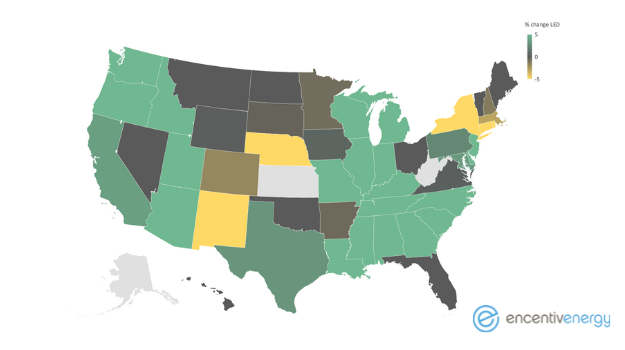
The highest percentage of change seen in our analysis was 48% and on the low end, approximately -22%. About 28 of the states are showing positive increases and 12 are negative. This is surprising, as the trend in downstream LED rebates has been relatively moderate over the past few years but we are seeing strong investment in these programs over the past few months and going into the 2023 program year. This is especially true in the South and Midwest, where we are seeing more utilities focusing on their downstream lighting programs.
LED Rebate Program Changes by State: Midstream
Midstream incentives are paid at the distributor level, with the discounts typically available to the contractor or a self-install customer at the point of purchase. The distributor provides the incentive through a discounted price and works with the utility directly to be reimbursed for the incentive, eliminating the paperwork requirements for the customer.
Overall, there has been more stability with midstream program rates this year with the number of states making increases, those that haven’t made changes remain close to even, at 13 vs 11, and only 5 programs decreasing rates and at a minimal level when compared to the increases.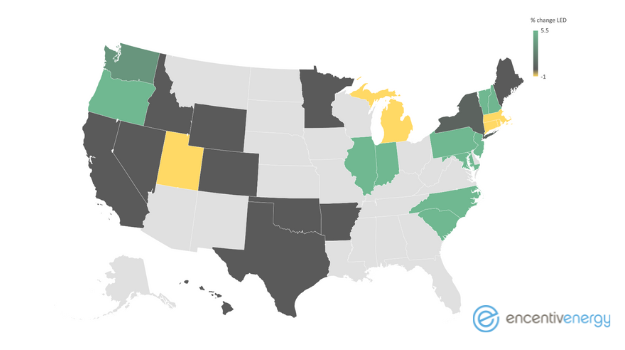
The color gradients on the map indicate the nature and magnitude of change with green representing incentive rate increases, with the most saturation showing over 50% (57.5% to be precise) in Oregon. Vermont showed increases last year and has continued that trend into 2023. The yellow gradient is representative of a decrease along the same scale but the changes here are all 15% or less.
Connecticut is an interesting situation, as they increased values last year, but we are now seeing their rebate rates reduced by approximately 8.4%. Differentiating between the gray tones, states in dark gray are those that have not changed rates since last year, while those that are light gray do not currently have a lighting midstream rebate program.
LED Rebate Changes by Program: Downstream
Getting down to the granular level of program changes of downstream changes for specific program:
- The Evergy Missouri program increased incentives up to 90% for linear fixtures, both outdoor and indoor
- In Chicago, Illinois, Commonwealth Edison, had another large rate increase similar to last year.
- Tennessee Valley Authority (TVA) EnergyRight Solutions for Business program, which operates in Alabama, Georgia, Kentucky, Mississippi, North Carolina, Tennessee, and Virgina, has had sweeping increases of about 33% across the board, plus an additional increase for lighting specifically
- Energize Connecticut generally trimmed their lighting incentives about 15% across all categories but compared to other territories these are still high rebates
- In New York, Consolidated Edison (ConEd) saw a larger dip in their indoor and outdoor linear incentives as a way to readjust their portfolio in this long-standing program
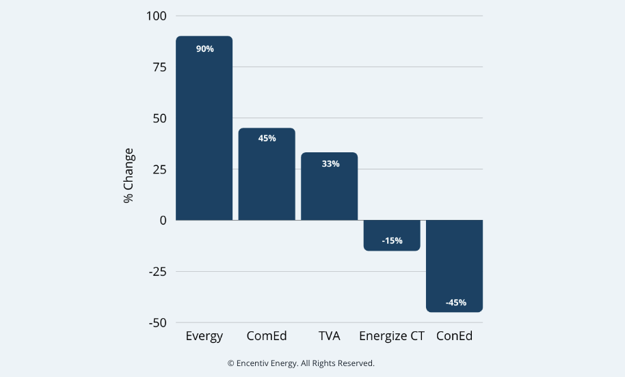
LED Rebate Changes by Program: Midstream
Taking a closer look at specific utilities that were driving these changes in midstream programs:
- The Energy Trust of Oregon increased instant discounts by up to 50% for some of their most popular lighting products such as HID replacement lamps, linear replacement lamps, high/ low-bay fixtures, and exterior fixtures
- In Efficiency Vermont we saw increases across the board last year and the trend has continued into 2023 with the program increasing incentives for high/low-bays and troffers
- Public Service Electric & Gas, commonly known as PSE&G, in NJ made increases to many of their midstream rebates in their Business Energy Saver Program including troffers, linear replacement lamps, exterior lighting, and even screw-base lamps for 2023
- The Energize Connecticut program increased incentives last year after starting a new program year but they have made slight reductions this year to troffers, troffer retrofit kits, replacement lamps for high/low-bays, as well as area and roadway luminaires. These changes are likely a way to adjust for the products that are being purchased through the midstream program, as well as looking at other measures
- Rocky Mountain Power’s Wattsmart midstream program in Idaho and Wyoming made reductions to incentive levels last year and now we are seeing similar reductions in Utah this year. The Utah midstream program has made reductions to the incentive levels for screw-base lamps and area and roadway luminaires
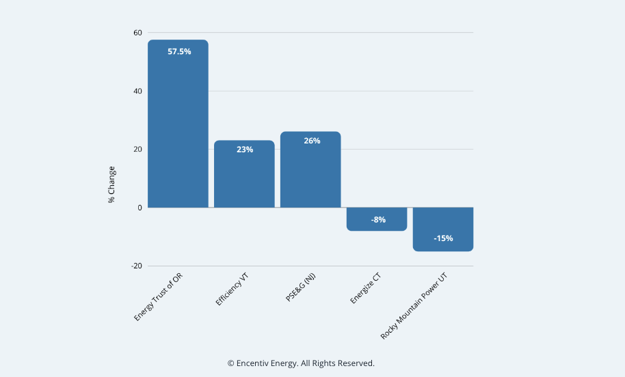
EISA Impacts
The Energy Independence and Security Act has been around since 2007, but two recent actions are having an impact on lighting and rebate programs. First, the DOE is requiring all general service lamps (GSL) to meet the LED standard of 45 lumens per watt. Second, they have amended the definition of GSLs to include most A-line, globe, decorative and reflector products.
Many energy-efficient CFLs and LEDs already meet the 45 lumens per watt requirement but this change will phase out halogen lighting products. It also adjusts the inefficient baseline used to calculate claimable energy savings for GSLs. This decreases the potential energy savings gained for the incentives provided on GSLs but it does not eliminate the savings.
These changes are having the greatest impact on residential rebate programs right now which may be why we are seeing increased incentives in other lighting categories on the commercial side of these programs. This will also impact GSLs in commercial rebate programs, with Massachusetts already slated to drop GSLs as of July 1, 2023.
LED Rebate Program Changes by Product Category: Downstream
Looking at the category level, for this analysis we took a look at every program across the US and the values are unweighted averages. An interesting pattern emerges when looking at the measures with the most significant increases for downstream programs, they are focusing on larger lighting elements like outdoor and parking lot lighting. Typical measures such as bulbs are seeing less of an increase due to several factors including more incorporation into midstream programs and also the impact of inflation and supply chain issues.
LED Rebate Program Changes by Product Category: Midstream
Similar to the downstream categories, we are looking at trends from category to category across the US and the values presented are unweighted averages across all utilities.
Aligning with the longevity of the rebates provided for this product category, first in downstream programs and then in midstream programs, screw-base categories are being reduced. This also may reflect the impact EISA is having on this product category as we discussed earlier in the presentation so we will continue to monitor that. In addition, fixtures like high-bays and troffers are seeing the largest increase for products in midstream. This coincides with downstream programs recently shifting focus for these products, transitioning them into midstream programs and often with higher incentives compared to last year.
HVAC
As there continues to be more focus on electrification, programs and incentives will continue to grow and expand for heating, ventilation, and air conditioning categories.
300+ programs, 830 utilities, 13m US business customers, 47 US states+DC, 9 CA provinces
Analyzing downstream rebates for HVAC, programs are almost as widely-distributed in commercial space as lighting. The overall trend is largely up, with a general rise in rates of about 20% year over year. This data is focused on electric incentives only and excluding chillers, which we just added into our database at the end of last year. 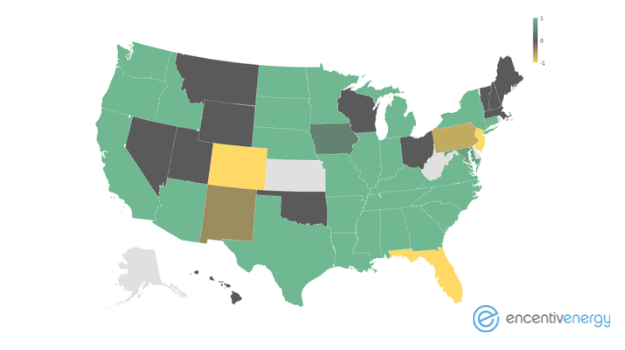 Mentioning TVA again, they have recently doubled their rates on a per ton basis for primarily heat pump and VRF systems. Connecticut has also launched a program, focused on heat pumps, raising rates to $250/ton and in a fuel-switching situation a business owner can apply for an additional electrification incentive of $2250/ton.
Mentioning TVA again, they have recently doubled their rates on a per ton basis for primarily heat pump and VRF systems. Connecticut has also launched a program, focused on heat pumps, raising rates to $250/ton and in a fuel-switching situation a business owner can apply for an additional electrification incentive of $2250/ton.
Find more information about HVAC incentives on UtilityGenius →
Ultraviolet Germicidal Irradiation
Ultraviolet Germicidal Irradiation (UVGI) is not a new technology but is newly incentivized. It is used most often to purify air and to keep heating or cooling coils clean in HVAC installations. Along with fresh air ventilation and filtration, UVGI is most notably recognized for its ability to remove pathogens from the air, including COVID-19. This is where utilities are beginning to incentivize, for the non-traditional and very specific application of eliminating air-borne pathogens in HVAC ductwork. At present, most states seen here incentivizing this technology are members of multi-utility programs.
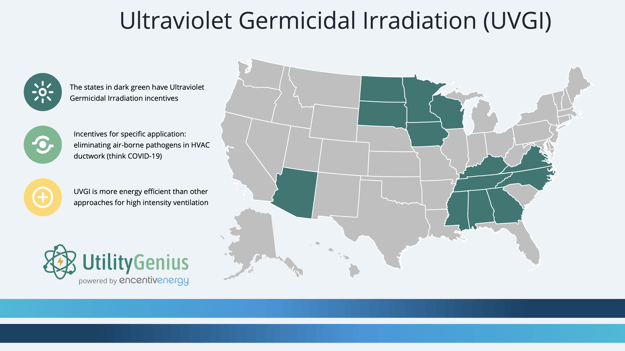
Networked Lighting Controls
Networked Lighting Controls incentive coverage has remained relatively unchanged over the year, seeing more adoption in the midwest and western side of the country. There are a wide variety of calculation methods for this technology across the programs that are currently offering incentives and often require DLC NLC listing to qualify.
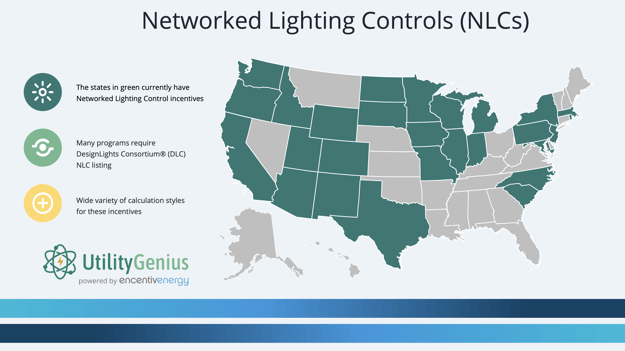
Horticultural Lighting
Since last year we have seen more programs incentivizing this led technology, including the addition of utility programs in Washington, Idaho, Oklahoma, and Louisiana. There has also been an uptake in programs adopting energy savings-based rebates, creating a much more diverse incentive landscape. States shown below in dark green have programs calculating incentives based on energy savings or reduced kWh, states in yellow have utilities incentivizing with per fixture rates, and states in light green have a mix of both across their programs.
The biggest driver for these changes is the increasing viability of LED technology for horticultural applications, with newer operations like indoor vertical farming and cannabis moving toward LED options.
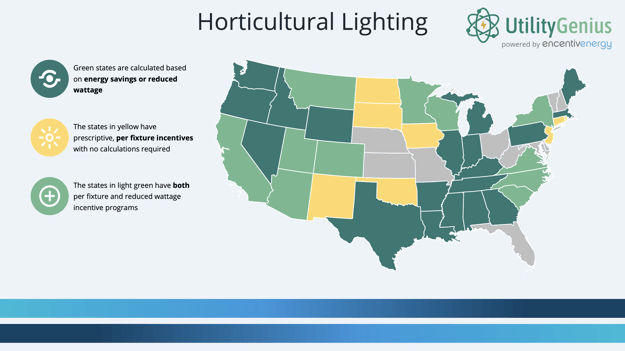
Electric Vehicles & Chargers
Over the past year, we have seen a saturation of utility-level incentives for both Electric Vehicles and the chargers powering them, with programs available in almost every state! As our first venture into tracking utility rebates outside of the commercial space, these programs include traditional residential EVs, as well as commercial vehicles and forklifts, and chargers of every level. 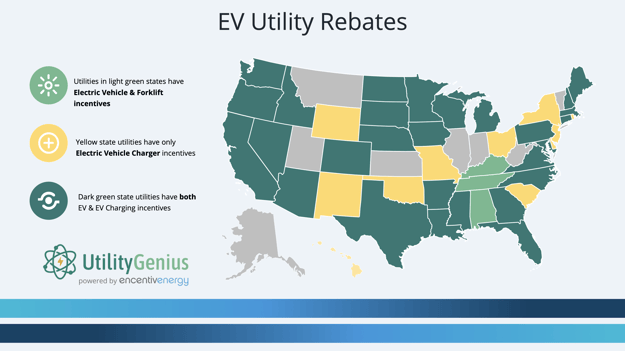
.png?width=500&name=2019%20e%20news%20spotlight%20logo%20(1).png)



